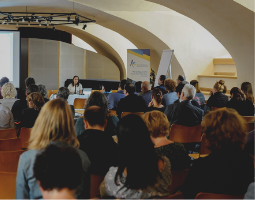The main aims of this document are to:
— Assist institutions in implementing the requirements of the Bolo- gna Declaration, and more speciï¬ cally in (re-)designing curricula and adopting a student and competence oriented approach
— Facilitate the recognition of studies and qualiï¬ cations and increase comparability and transparency in the higher music edu- cation sector by deï¬ ning reference points in terms of learning outcomes and competences
— Provide current or potential students with a clear presentation of the main aspects of a higher music education curriculum and its opportunities
— Offer a clear overview of the higher music education sector to a wider audience by using the ‘Tuning’ methodology and providing a musical translation of the ‘Dublin Descriptors’
— Assist institutions and relevant stakeholders in quality assurance and accreditation processes in higher music education
— Help employers and other stakeholders to understand the com- petences of musicians they hire.
The term Higher Music Education is used to characterise musical studies undertaken in the context of Higher Education that have a primary focus upon the practical and creative development of the student (Section 2). Higher music education aims to give each student an optimal environment for developing a distinctive artistic proï¬ le. Such an environment appreciates the individuality of each staff and student, and values and supports the search for and sharing of knowledge, as well as open discussion and dialogue.
Higher Music Education is now generally accepted across Europe as a discipline appropriate to 1st and 2nd cycle studies in higher education. An increasing number of conservatoire-style institutions either run or are developing 3rd cycle studies. With the aim to show the compatibility of the higher music education sector with the descriptions for the 1st, 2nd and 3rd levels in higher education in the ‘Dublin Descriptors’, the ‘Polifonia/Dublin Descriptors’ were developed as a ‘musical’ version of the original ‘Dublin Descriptors’ (Section 3). Due to several factors, the concept of employability is complicated when applied to Higher Music Education.
The characteristics of learning, teaching and assessment in Higher Mu- sic Education are briefl y presented in Section 6 and illustrated by exam- ples of courses/programmes from different institutions describing learn- ing outcomes and assessment methods in Higher Music Education and pointing out the close connection of well articulated learning outcomes to ï¬nal assessment criteria (Appendix E).
Section 7 presents the position of the European Association of Con- servatoires (AEC) regarding quality assurance and accreditation in mu- sic, and presents the framework for quality assurance and accreditation developed by the Association to assist higher music institutions in their quality enhancement activities. This framework uses the AEC/Polifonia Learning Outcomes and the ‘Polifonia/Dublin Descriptors’ presented in this document as reference points.






